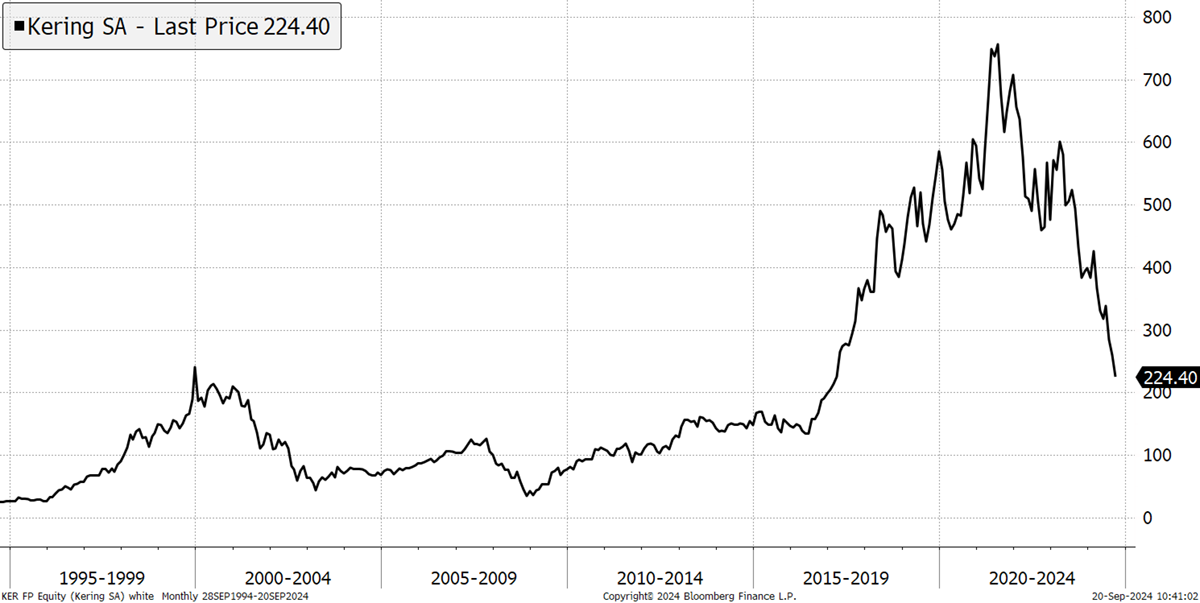The Crumbling House of Gucci

Disclaimer: Your capital is at risk. This is not investment advice.
This week saw interest rates fall, and the hope is that this preemptive 0.5% cut from the Fed will thwart a recession. This is the start of a cutting cycle, which is likely to continue with rates below 3% by the end of next year. At least that is the current forecast.
While that’s great for us mere mortals who can look forward to locking in cheaper mortgages, please spare a thought for the rich. Not only did rates fall, but Gucci’s parent, Kering, did too. Kering’s shares are down 70% since 2021 and have failed to participate in the post-2022 bull market. The rich must be tightening their belts.
Gucci Discounts

But it’s not just the rich that buy luxury goods. Many people see them as aspirational purchases, and the message from the luxury goods sector is that the good times are over. Kering’s revenue for the first half of 2024 was down 11% on last year, with “market conditions unsupportive in most regions except for Japan [where there is a tourism boom due to the cheap yen].” This means that the marginal buyer has cut back on luxury goods, which is the opposite of what caused fashion houses to thrive in the first place. Wealth creation has slowed.
It's not just Gucci that’s in trouble. €100 invested in Burberry ten years ago is now worth €36. The others have fared better, but there are two distinct groups, with Burberry, PRADA, and Richemont in the lower and Hermes, LVMH and Moncler in the upper. Yet Kering has dropped from the upper to the lower, and I suspect others will follow.
Luxury Debagged

Luxury goods are high-margin, cash-generative products. LVMH manages to achieve 68% gross margins, and Hermes, over 70%. Hermes is the last holdout. It trades on 14x sales, so it could easily be mistaken for a software company. The dividend yield is a modest 1.3%, but since the family own two-thirds of the stock, with a €204 billion valuation, I’m sure they’ll cope.
It’s more evidence of a thinning market. Fewer stocks can manage to maintain high valuations because they are priced as ultra-high-quality-growth stocks that are struggling to grow. Deratings are painful. Imagine what will happen when the technology sector runs out of growth.
Here at ByteTree, we are experts in luxury goods. Unlike handbags, which depreciate after purchase, we prefer gold, which seems to appreciate over the long term.
A Week at ByteTree
With gold trading above $2,600, it is clearly enjoying the cuts in interest rates. It doesn’t seem to mind the slack in spending on luxury goods because its market is a cut above. The luxury goods industry is expected to generate sales of $400 billion this year, while gold’s newly mined 3,500 tonnes will fetch a lesser $300 billion. But its clients aren’t just rich; they are nation-states. The latest buyer is Saudi Arabia, who were exposed by Jan Nieuwenhuijs. They were discreetly buying 160 tonnes through Switzerland. Demand for gold from the world’s central banks keeps on coming, and as I highlighted, Wall Street has joined in too.

I covered this in the latest Atlas Pulse, along with more thoughts on interest rates and the money supply.
For those who agree that for best results, a little Bitcoin should be mixed in with your gold, then you’ll be delighted to hear that 21Shares announced the annual management fee on the 21Shares ByteTree BOLD ETP (BOLD Switzerland) has been reduced from 1.49% to a more institutionally agreeable 0.65%, now that assets have exceeded $10 million. A special thank you to all of BOLD’s investors.
In ByteTree Venture, I selected a deep-value oil and gas stock from the North Sea, which will generate its entire market cap in free cashflow by 2027, regardless of the new Labour government’s punitive budget.
In The Multi-Asset Investor, I looked at the curious link between oil and bond yields, and in crypto, we covered TON, TRON, and Monero. I also highlighted a report by Nic Carter, in conjunction with Visa, which looked at the business of Stablecoins. It’s a must-read, especially if you still think crypto has no use case; $160 billion of stablecoins active in the emerging markets suggests otherwise.
Have a great weekend,
Charlie Morris
Founder, ByteTree
